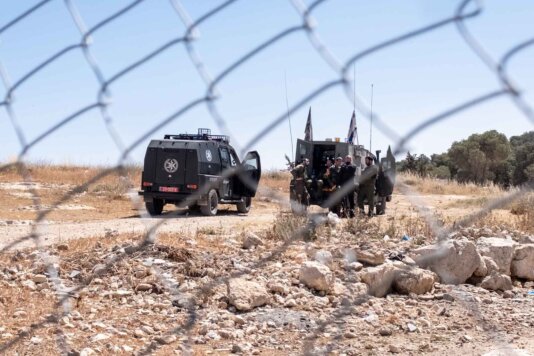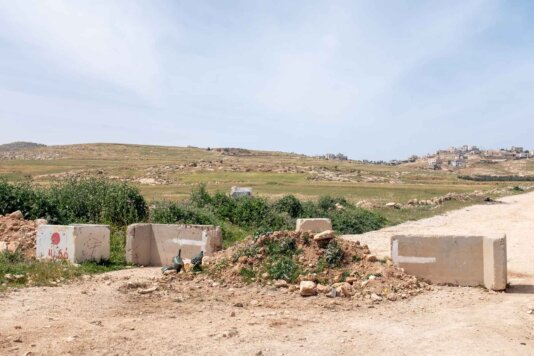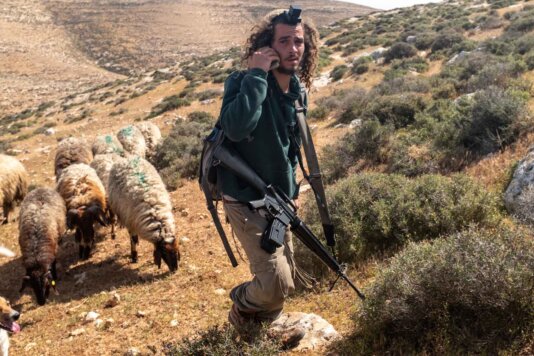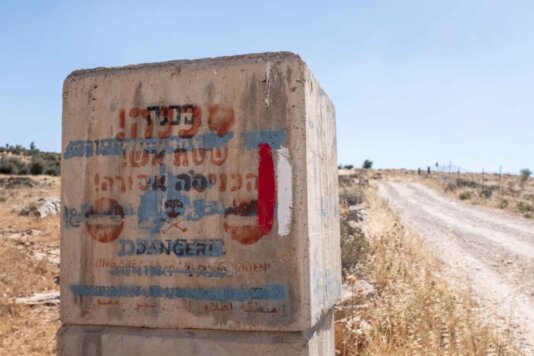- About
- Topics
- Story
- In-Depth
- Picks
- Opinion
- News
- Donate
- Signup for our newsletterOur Editors' Best Picks.Send
Read, Debate: Engage.
| June 06, 2024 | |
|---|---|
| topic: | Political violence |
| tags: | #Israel, #Palestine, #West Bank, #occupation |
| by: | Aidan Frere-Smith |
On 7 June 1967, Israeli military forces occupied the Palestinian territory of the West Bank following the Six-Day War. Under United Nations Resolution 242, it was declared that the occupation was illegal and military forces should immediately withdraw.
Instead, the Israeli state established military courts and other legal frameworks to circumvent international law and remain an occupying force.
This would also be utilised for the expansion of settlement developments in the West Bank, as seen in a 'master plan' published in 1979.
Following the publishing of classified documents in 2022, it was reported that the then-Agricultural Minister of Israel Ariel Sharon attended a secret-meeting of the World Zionist Organisation’s (WZO) Settlement Division in 1979 and stated that his role in initiating military fire zones in 1967 'were all intended for one purpose: to provide an opportunity for Jewish settlement in the area.'
Multiple UN resolutions at the time, including 446, 452, 465, 471 and 476, deemed the occupation and subsequent settlements as illegal.
One of the military training areas declared was Firing Zone 918, in Masafer Yatta (MY); an area in the south Hebron Hills, which contains a multitude of Palestinian hamlets and villages.
It was later revealed, following the publication of a transcript of a joint government meeting with the WZO in 1981, that Sharon went further by specifically instructing military forces to establish training zones for the purpose of displacing Palestinian residents.
Harassment, violence and other forms of oppression have been implemented ever since, gradually becoming more intense over time, and has escalated significantly since October 2023.
Speaking to FairPlanet, Musahb Rabai, a life-long resident of MY, shared a personal account of life under occupation and the international solidarity that is being shared with Palestinians on the ground.
"The people were living a simple life," Musahb told FairPlanet. He explained that their lifestyle predominantly revolved around a traditional reliance on the land, through activities like harvesting and grazing, a relationship that endures to this day. His family is no exception, having resided in and around the village of At-Tuwani in MY for centuries.
A key argument used by the Israeli authorities to justify the forcible displacement of Palestinians is based on their own misinterpretation of a field study, claiming that there are no 'permanent dwellings' in the area, and that residents are 'seasonal.'
But Musahb responded with frustrated laughter and confidently affirmed, "The age of my father in his life now is over 90 years old," which in itself pre-dates the creation of the Israeli state in 1948.
Continuing to demonstrate the generations beyond his grandparents who were born locally, he concluded, "we have lived in this village all of our lives."
Though "the occupation started many years ago," he explained, "the main attack started around 1991," following the establishment of the Havat Ma’on settlement.
He added that premeditated and coordinated attacks against residents took place on a regular basis throughout MY, as seen in one case study conducted by Israeli human rights NGO B'tselem. The report details various abuses, including the beating of children, damaging of property, burning of crops and driving away of livestock.
This situation escalated significantly in 1999. According to a detailed account by B'tselem published the following year, 700 Palestinian residents in MY were forcibly expelled following evacuation orders issued by Israeli authorities.
"They took all the people from the [hamlets and] villages and threw them outside [the entrance of] At-Tuwani," explained Musahb. But the communities did not give up.
Together, the Palestinian population of MY responded by petitioning the Israeli High Court of Justice in 2000, resulting in a legal challenge that was drawn out over twenty years. An interim injunction initially permitted them to return, but homes and whole villages had already been demolished, meaning lives had to be rebuilt.
While many attempted to reestablish a traditional way of life, aligned with their identity and connection to the land, the oppression against them resumed.
The means of doing so had not changed, but became more severe according to local residents. "The Havat Ma’on [settlement] started so small," explained Musahb, "but it was terrible for the Palestinian people."
One detailed report by B'tselem from 2005 breaks down the means of 'expansion of settlements and annexation of territory.'
Firstly, a systematic approach was carried out by Israeli police, the army and other governmental authorities, and included the refusal to permit building and development, restricting freedom of movement as well as the destruction of homes, farmland and supportive infrastructure used for basic needs.
Settler violence played an additional systemic role, with tactics including beatings and other physical violence, shooting and poisoning of livestock as well as setting dogs on children, notably without legal ramifications.
Musahb attested to the impact this had on the community: "Step by step, less and less people were living there and travelling as they had so many problems."
Two decades on, forced expulsion remained a consistent threat for Palestinians due to increased Israeli-sanctioned settler-expansion and subsequent violence, as well as demolition orders issued and carried out by Israeli forces, as detailed in a 2021 UN case study report.
"They used Havat Ma’on as a way of connecting the settlers," Musahb shared, "and kept building elsewhere."
In 2022, the Israeli High Court of Justice ruled against the petitioners. Subsequently, the campaign to forcibly displace Palestinians intensified. Demolitions of homes were carried out within days and continued well into the following year, including one poignant example which resulted in 13 families, including 44 children, being forced from their homes.
As another example, Israeli forces destroyed a school and used 'sound bombs' to scare children away.
This escalation is not only specific to demolitions. Limitations imposed on Palestinians freedom of movement have become more severe due to the increased presence of Israeli checkpoints and forbidden roads. Families who are forced to move, pre- and post-eviction, are still liable to suffer further by having their vehicles confiscated and detained when attempting to pass through.
This also applies in everyday life to those travelling to buy food, seeking medical care or attending a hospital for an emergency, as outlined in the documentary 'Forced From Home.'
The situation has further worsened following the 7 October attack by Hamas on Israel last year, during which 1,200 people were killed and over 250 were kidnapped, most of them civilians. Musahb believes the Israeli state used this as an opportunity to further embolden settlers by providing them with firearms and recruiting them into the army.
"They act however they want," he said, "like they don’t have to take orders from anyone."
According to an update published by the UN Office for the Coordination of Humanitarian Affairs, there have been 829 settler attacks on Palestinians and their properties, resulting in casualties, as well as the displacement of 1,790 residents, 78 per cent of which are children, as a result of demolitions in the West Bank between October 2023 and May 2024.
Some are calling it the 'new nakba.'
Built before Firing Zone 918 was declared, Musahbs’ family home sits on the edge of At-Tuwani, which is technically located outside of the zone. However, the road adjacent to his home leads directly to the Israeli Havat Ma’on settlement; thus making him and his family vulnerable.
Despite living under occupation, a connection to the land was somewhat maintained. "We ploughed, we grazed, we grew," stated Musahb. However, following 7 October 2023, everyday life became severely more difficult and at times, impossible, he shared.
He explained that "they want to use the time of the war [in Gaza] to further what they’ve been trying for decades.
"In the first week, the settler beat me, my cousin and shot my neighbour beside my house."
The following week, Musahbs’ family home was raided by soldiers who claimed to be searching for weapons Musahb said did not exist. He details the aftermath: "They broke everything, even the toys of the baby. And they stole anything they wanted, even the [copper] metal from the wires."
Making matters worse, the large sack of flour which was used for daily bread making, was sliced open onto the floor.
Musahb has suffered regularly in recent months, he said; sometimes as many as four to five incidents daily, night and day, which range from intimidation and threats to outright violence. He installed cameras and lighting to record evidence of what was happening, but those were either stolen or destroyed. More were installed, but out of reach from within the house. "But they continue to try," he said, "and now they wear masks."
Such incidents have also been reported elsewhere. "If you graze the sheep, if you plough the field, if you pick the olive, if you harvest the wheat, the settler has a problem," Musahb said. "And they have the soldiers [on their side]."
Notably, the conduct of Israeli forces and settlers has a psychological impact, resulting in trauma and long term effects on Palestinians' mental health.
"It is such a bad feeling," Musahb shared. Since October 2023, he has been unable to sleep properly and when he does rest, it is though he has one eye closed while the other stays open. He confesses "you were scared all the time;" a feeling which is shared amongst his family.
During the peak of harassment and violence in MY, during the early stages of Israel's invasion of Gaza, Musahbs’ children were crying "all the time." Explaining why, he recalled a 'consistent presence;' "if it wasn’t a soldier or a settler, it was a drone."
He insisted, however, "I will continue in my way," vowing not to let fear overcome him.
This attitude is shared collectively among the Palestinians of MY, and demonstrated by those who remain. For them, residence in itself is a form of resistance.
But Musahb, his family and the residents of MY are not on their own.
Acting in solidarity, international and left-wing Israeli supporters of Palestinian rights have taken upon themselves to join those in the West Bank and beyond, many through the International Solidarity Movement (ISM), a Palestinian-led organisation that supports nonviolent resistance to the occupation.
Though the number of international supporters has fluctuated since the NGO's formation in 2001, a consistent presence has remained. The means of support has also varied overtime, but one tactic has always been maintained: evidence gathering.
Amira, an activist speaking on behalf of ISM, told FairPlanet that this is achieved through what they term "protective presence" by accompanying Palestinians while they work the land and residing with them. She explained the purpose is to "bear witness, document the atrocities, and report back to the world" as a means of amplifying Palestinian voices. By doing so, she believes they can provide the residents of MY with some comfort as their presence acts as a deterrent to the settlers and Israeli authorities.
"They have become more distant," confirmed Musahb. Despite the increased hostilities and efforts to expel the residents of MY since 7 October, 2023, he is confident that activists do in fact make an impact. Amira shared that "when days are calm, activists can experience what life should be like; sitting with the family and drinking tea while watching the kids play and dance."
"With the camera, recording from start to finish, they cannot lie," Musahb affirmed, adding that "we have it a little bit better than before. If this [support] stopped, the situation would be worse."
Musahb recalled when soldiers came to his home while activists were present. "They broke all our phones, and told me if activists were here again, they would beat my children in front of my eyes."
Threats such as this, he believes, demonstrate the frustration that comes with knowing their behaviour could be exposed.
In fact, it is such a hindrance to occupational efforts that Israeli far-right ultranationalist National Security Minister Itamar Ben Gvir reportedly formed a dedicated police unit to target 'left-wing activists' who share solidarity with Palestinians in the West Bank.
In addition to facing arrest and deportation, activists also risk their own safety. In 2003, ISM activist Rachel Corrie was crushed to death by an armoured bulldozer driven by an Israeli soldier while she prevented the demolition of a Palestinian home.
Two decades on, the risk to life remains very much real, as seen by settlers shooting live ammunition at ISM and Israeli activists and local residents who were documenting the destruction of a Palestinian olive trees.
Ultimately, there are limitations to the impact of solidarity efforts. Indeed, intimidation, harassment and violence continues to be documented. But the demolition of Palestinian homes and sanctioning of new settlements persist.
But Musahb, as well as the many residents of MY who are at risk, are grateful for any support they can get. Collectively, he expressed, the struggle is seen to be a solitary one with little, if any, support on the international political stage; "it is just the people who support each other, with help from activists."
Yet, the Palestinian struggle for freedom against occupation in MY, and throughout the West Bank, continues. And while the future is uncertain and optimism is limited, Palestinians remain.
"They can take our land and they can take our life," Musahb concluded, "but they can't take our joy. And they can't take our heart."
Picture by Aidan Frere-Smith
By copying the embed code below, you agree to adhere to our republishing guidelines.




